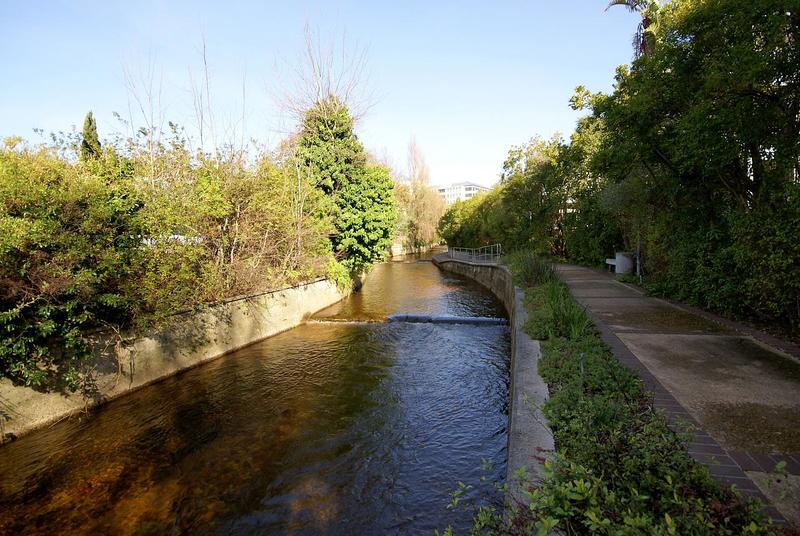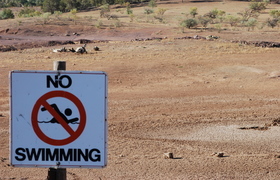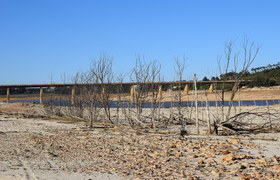Harvesting the storms
19 September 2017 | Story Ambre Nicolson. Photo Danie van der Merwe via Flickr.
Cape Town uses about 300 million cubic metres of water annually, most of which comes from the six major reservoirs. But every year four times as much as that falls on the city as rain. Now civil engineer and PhD researcher John Okedi is studying ways in which this water can be used to offset the current water shortage.
At present, most of the storm water that falls on the city (an area of 2 445 square kilometres) is managed through a network of ponds and channels that divert it into rivers and from there to the sea. While this is the case in most parts of the world, this system of managing storm water leads to higher flows of poor quality water downstream. Worst of all, the water goes unused in times of water scarcity.
What is storm-water harvesting?
It was around 1990 that the developed world – led largely by Australia, which has a climate very similar to South Africa – started promoting a different approach to storm water drainage, called Sustainable Drainage Systems (SuDS), which mimics natural systems. Such systems not only prevent flooding through the safe drainage of relatively good quality storm water, but also consider storm water as key to the promotion of social amenities such as parks and lakes, the preservation of biodiversity and, most significant here, as a valuable water supply if it can be effectively stored and treated.
The problem with this idea, as Professor Neil Armitage, director of the Urban Water Management research unit and deputy director of the Future Water research institute, puts it, is that “the water does not arrive in a very user-friendly format.” In other words, while the volume of water is large, it is both difficult to store and often very dirty since it has fallen in an urban area. In addition, storm-water harvesting may also not be cost effective, although it is generally much cheaper than some of the more ‘popular’ alternatives, such as sea-water desalination.
The Lotus River was originally constructed around the same time as Cape Town International Airport to serve as a drainage channel for the area. According to Mr John Okedi, a PhD student working with Prof Armitage, the average annual flow down this river is in the region of 15 million kilolitres, most of which ultimately reaches False Bay via Zeekoevlei. Meantime, a recent study by a former PhD student, has shown that storm-water harvesting in the Liesbeek River catchment – which includes UCT – could reduce the need for potable water in the area by up to 20% if the stormwater is only used to flush toilets and water gardens. This suggests that similar benefits may be accrued by using the water of the Lotus River.
But how can this water be effectively stored? One way, according to Okedi, is to exploit some of the approximately 800 retention ponds in Cape Town that are usually empty until required for flood management.
“There is already quite a substantial network of ponds in the city,” he says. “It is possible to use some of the 60 ponds in the Lotus River catchment for longer-term storage while still being available, through pre-emptive discharge prior to major storms, to control flooding.”
Aquifer recharge management
But there is another way. Much of the Cape Flats is made up of beach sand, in some places in a layer up to 50 metres thick. The porosity of this type of sand is 30%. A mere three metres of this, the so-called Cape Flats Aquifer (CFA), in the region of the Lotus River is theoretically sufficient to store up to 100 million cubic metres of water. Bearing this in mind, Okedi and others have been looking into the possibility of managed aquifer recharge (MAR). This is the artificial management of the levels of water in the aquifer by encouraging infiltration in selected spots, which makes water available for later extraction via boreholes. An added attraction of this approach is that MAR offers an element of water treatment.
“If we can get it right, this could potentially relieve the city of the need to supply 33 million kilolitres of potable water per year.”
According to Okedi, the method is already being implemented in other parts of the world, such as the Netherlands and Denmark, as well as locally on a smaller scale in Atlantis, north of the city.
“We know it works,” he says. “In Atlantis, storm water is infiltrated into the local aquifer through two large ponds, to be abstracted as required by a system of boreholes. This has ensured a steady supply of water for some 40 years.
“In the case of the CFA, the catchment has been subjected to considerable impacts from land uses as diverse as solid-waste disposal sites, informal settlements and agricultural practices. What we don’t know is the long-term impact in terms of the various pollutants as well as the feasibility of using the system at this scale. However, if we can get it right, this could potentially relieve the city of the need to supply 33 million kilolitres of potable water per year – which is more than 10% of the current average supply using MAR in the Lotus River catchment.”
Unfortunately, building the infrastructure for such a system would take several years in Armitage’s opinion.
“This is not an immediate solution, but it could be a valuable way to supplement our city’s water supply in the future,” he says.
 This work is licensed under a Creative Commons Attribution-NoDerivatives 4.0 International License.
This work is licensed under a Creative Commons Attribution-NoDerivatives 4.0 International License.
Please view the republishing articles page for more information.










